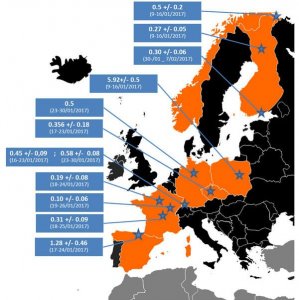Increased levels of radioactive iodine isotopes have been detected across Europe, and now the deployment of the Air Force’s WC-135 “Constant Phoenix” atmosphere-sniffing jet has deepened the mystery.
By Tyler Rogoway February 19, 2017
There have been rumblings regarding some sort of nuclear incident—or possibly incidents—in the Arctic over the last month. Multiple reports, some of them from official monitoring organizations, have reported iodine 131—a radioactive isotope often associated with nuclear fission—has been detected via air sampling stations throughout the region.
The first detection of the isotope came during the second week of January, via an air sampling station located in Svanhovd, on Norway’s border with Russia’s Kola Peninsula. Within days, air sampling stations as far south as Spain also detected the presence of small amounts of the isotope. The fact that iodine-131 has a half-life of just eight days would point to the release occurring just days earlier, and not being a remnant of a past nuclear event.
Because of the low levels of concentration, there is no health risk to the public or the environment, at least on a wide scale. By comparison, these recent measurements are roughly 1/1000th the size of what was detected during the Fukushima incident and 1/1,000,000th the concentration found in the nuclear tainted cloud that washed across Europe following the Chernobyl disaster.
Iodine 131 levels monitored across Europe last month (IRIN graphic)
(... to be continued ...)
By Tyler Rogoway February 19, 2017
There have been rumblings regarding some sort of nuclear incident—or possibly incidents—in the Arctic over the last month. Multiple reports, some of them from official monitoring organizations, have reported iodine 131—a radioactive isotope often associated with nuclear fission—has been detected via air sampling stations throughout the region.
The first detection of the isotope came during the second week of January, via an air sampling station located in Svanhovd, on Norway’s border with Russia’s Kola Peninsula. Within days, air sampling stations as far south as Spain also detected the presence of small amounts of the isotope. The fact that iodine-131 has a half-life of just eight days would point to the release occurring just days earlier, and not being a remnant of a past nuclear event.
Because of the low levels of concentration, there is no health risk to the public or the environment, at least on a wide scale. By comparison, these recent measurements are roughly 1/1000th the size of what was detected during the Fukushima incident and 1/1,000,000th the concentration found in the nuclear tainted cloud that washed across Europe following the Chernobyl disaster.
Iodine 131 levels monitored across Europe last month (IRIN graphic)
(... to be continued ...)

